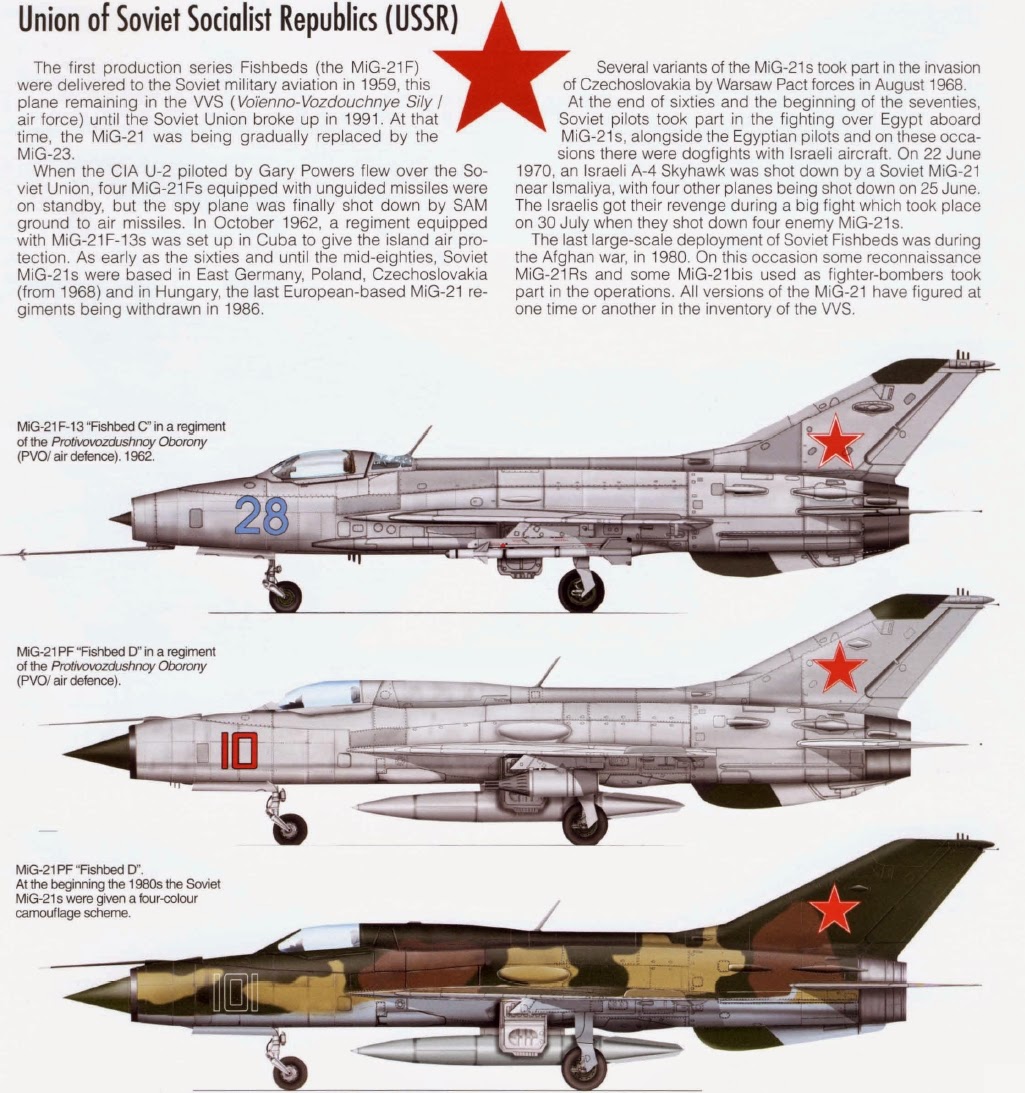The Mikoyan-Gurevich MiG-21 (NATO reporting
name "Fishbed") is a supersonic jet fighter aircraft, designed by the
Mikoyan-Gurevich Design Bureau in the Soviet Union. It was popularly nicknamed
"balalaika", from the aircraft's planform-view resemblance to the
Russian stringed musical instrument or ołówek (English: pencil) by Polish
pilots due to the shape of its fuselage. Early versions are considered
second-generation jet fighters, while later versions are considered to be
third-generation jet fighters. Some 50 countries over four continents have
flown the MiG-21, and it still serves many nations a half-century after its
maiden flight. The fighter made aviation records. At least by name, it is the
most-produced supersonic jet aircraft in aviation history and the most-produced
combat aircraft since the Korean War, and it had the longest production run of
a combat aircraft (1959 to 1985 over all variants).
#
The classic MiG 21 is the most extensively
exported jet fighter in history. It has fought in several wars and continues in
frontline service four decades after its appearance.
The experience of air combat in Korea
forced the Mikoyan design bureau to draw up radical plans for a new
air-superiority fighter. This machine would have to be lightweight, be
relatively simple to build, and possess speed in excess of Mach 2. The prime design
prerequisite entailed deletion of all unnecessary equipment not related to
performance. No less than 30 test models were built and flown through the mid-
to late 1950s before a tailed-delta configuration was settled upon. The first
MiG 21s were deployed in 1959 and proved immediately popular with Red Air Force
pilots. They were the first Russian aircraft to routinely operate at Mach 2 and
were highly manoeuvrable. Moreover, the delta configuration enabled the craft
to remain controllable up to high angles of attack and low air speed. One
possible drawback, as with all deltas, was that high turn rates yielded a steep
drag rise, so the MiG 21 lost energy and speed while manoeuvring. This was
considered a fair trade-off in terms of overall excellent performance. More
than 11,000 MiG 21s were built in 14 distinct versions that spanned three
generations of design. They are the most numerous fighters exported abroad, and
no less than 50 air forces employ them worldwide. The NATO code name is
FISHBED.
The MiG 21 debuted during the Vietnam War
(1964–1974), during which they proved formidable opponents for bigger U.S.
fighters like the McDonnell- Douglas F-4 Phantom. Successive modifications have
since endowed them with greater range and formidable ground-attack capability,
but at the expense of their previously spry performance. Russian production of
the MiG 21 has ended, yet China and India build, refurbish, and deploy them in
great numbers. These formidable machines will undoubtedly remain in service for
many years to come.
Specifications
(Mikoyan-Gurevich MiG-21F-13)
General characteristics
Crew: 1
Length: 15.76[50] m (51 ft 8.47 in)
Wingspan: 7.154 m (23 ft 5.66 in)
Height: 4.1 m (13 ft 5.41 in)
Wing area: 23.0 m2 (247.3 ft2)
Empty weight: 4,871 kg (10,738 lb)
Gross weight: 7,100 kg (15,650 lb)
Powerplant: 1 × Tumansky R11F-300, 37.27 kN (8,380 lbf) thrust dry,
56.27 kN (12,650 lbf) with afterburner each
Performance
Maximum speed: 2,125 km/h (1,385 mph)
Maximum speed: Mach 2.05
Range: 1,580 km (981 miles)
Service ceiling: 19,000 m (62,335 ft)
Armament
1x internal 30 mm NR-30 cannon, plus
2x K-13 or K-13A (R-3S) AAM or
2x 500 kg (1,102 lb) of bombs





No comments:
Post a Comment